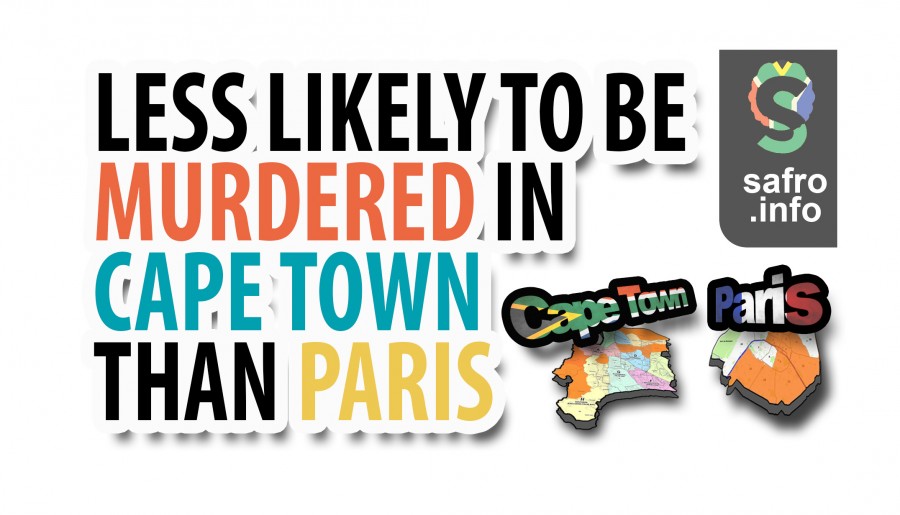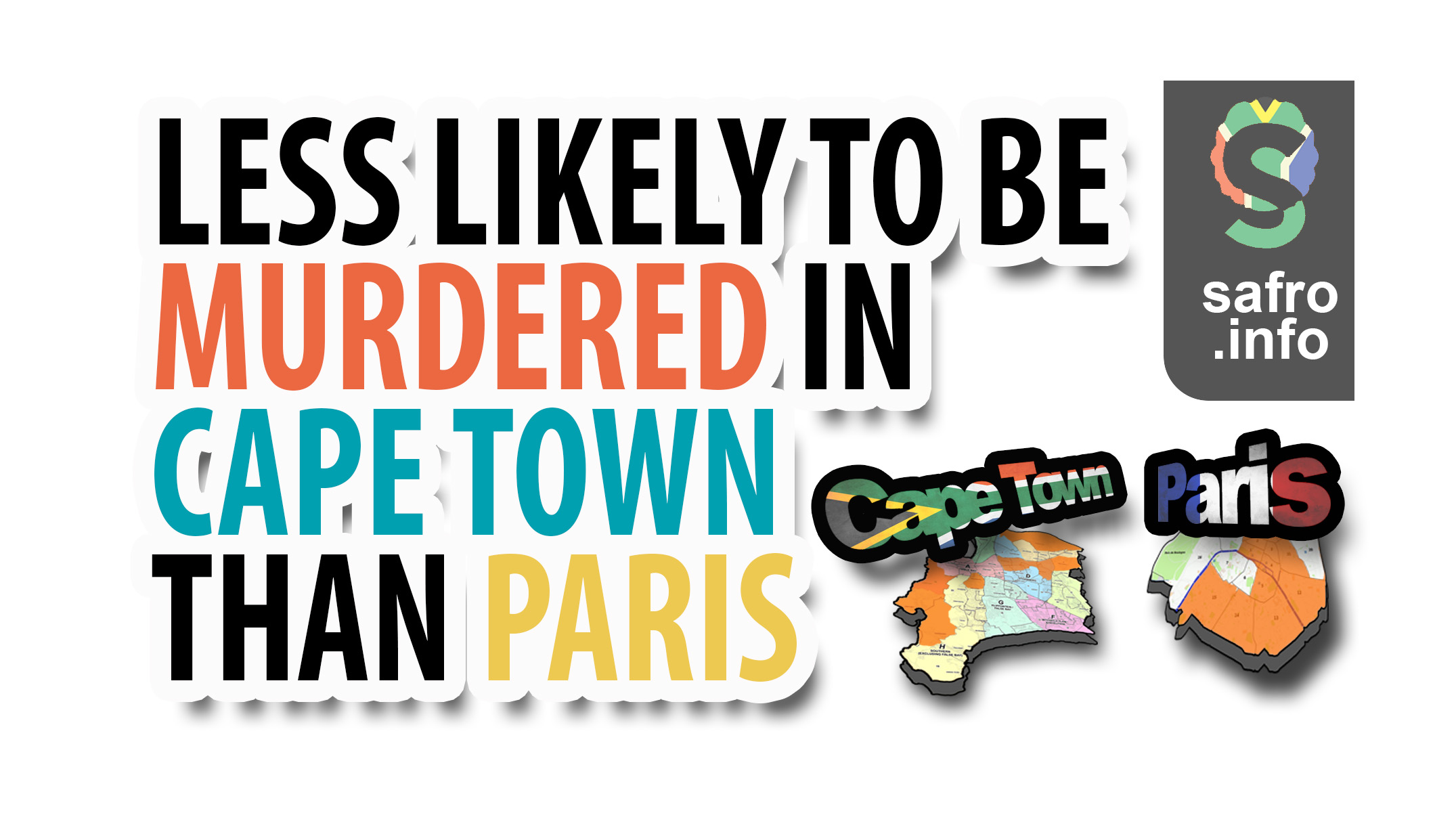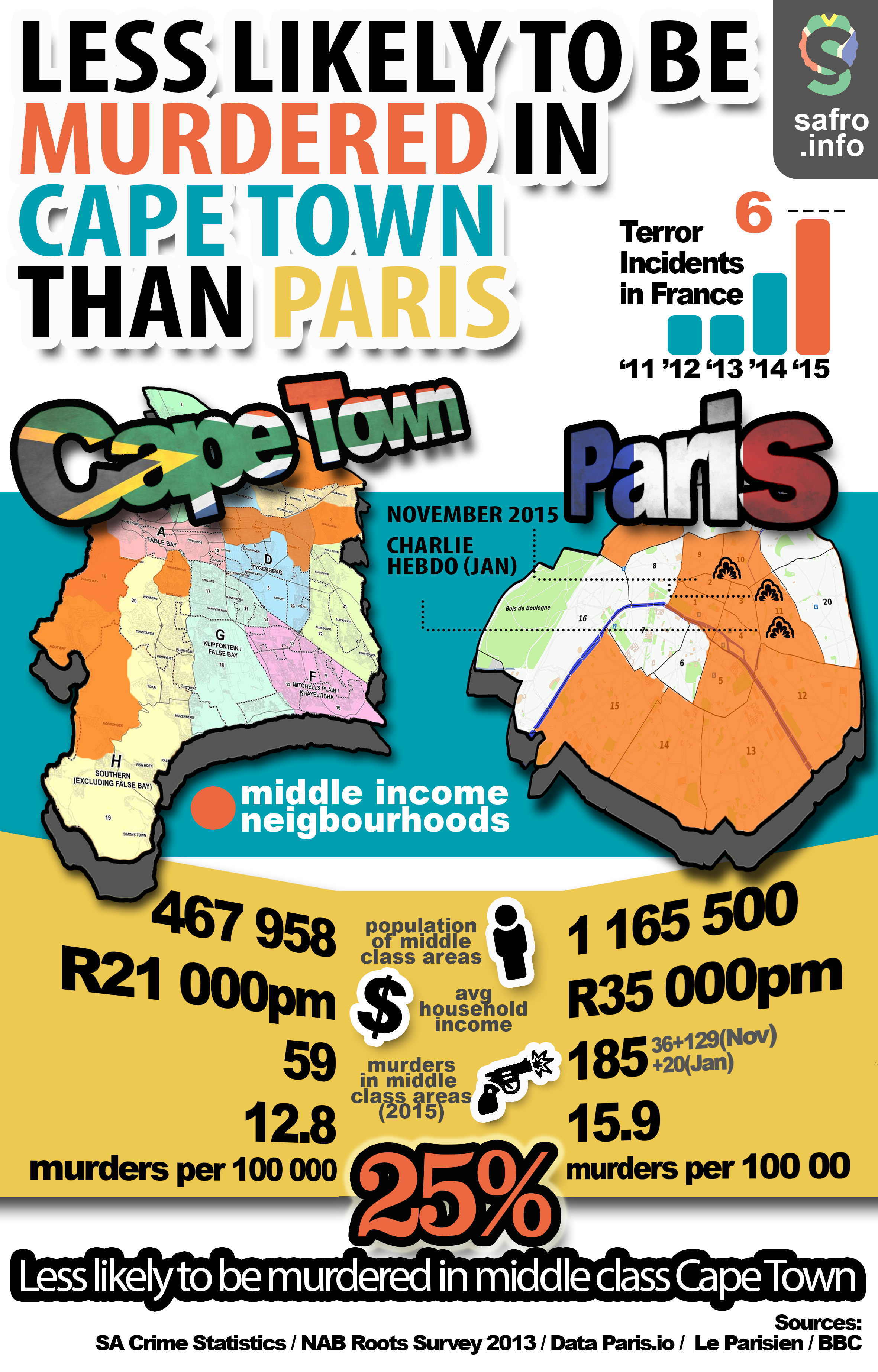
Cape Town Safer than Paris, At Least So the Stats Say
This article is not meant to belittle the horrible events that occurred in Paris on 13 November but to highlight the notion that the winds of change have brought new terrors that should make one rethink traditional conceptions of safety. Eleven-Thirteen (11-13) is another infamous date to be added to 9-11 and 7-7; another senseless act of terror; another deadly […]

This article is not meant to belittle the horrible events that occurred in Paris on 13 November but to highlight the notion that the winds of change have brought new terrors that should make one rethink traditional conceptions of safety.
Eleven-Thirteen (11-13) is another infamous date to be added to 9-11 and 7-7; another senseless act of terror; another deadly attack in Paris in 2015 (following the January attacks on Charlie Hebdo). The worst terror incident ever recorded in French history left at least 132 people dead. Has one of the safest European cities become, overnight, one of the deadliest?
France (usually) has one of the lowest murder rates in the world (1 murder per 100,000 people). In comparison, South Africa has one of the highest murder rates (31 per 100,000). An unfortunate determinant of crime, and murder rates, is that it correlates with socio-economic circumstances – poor people are more affected by it than the rich. This remains true wherever in the world you might find yourself – crime discriminates based on income.
Terrorism, on the other hand, does not. If anything, terrorists target the middle-class to maximise fear in the majority of a country’s populace. The question is: With the recent rise in terror incidents in France (none in 2011, 1 each in 2012 and 2013, 3 in 2014, 6 in 2015) culminating in the most recent attacks, how safe is Paris for the average middle-class citizen compared to a major South African city such as Cape Town? Let’s do some research and find out.
I WOULD CUT FROM HERE
Who Are the Middle Class?
This section compares the murder rates (including those related to terrorism) in middle class neighbourhoods of Cape Town and Paris to see which has been the most deadly in 2015.
CUT TO HERE.
Firstly we have to establish which areas of Cape Town should be considered middle class. The company NAB (Marketing Insights and Advice) releases a Roots Survey every three years – the last was in 2013 – that measures the buying and media behaviour of SA’s urban households.
One of the key factors in this survey is the average household income of different areas of major cities, including Cape Town. The results were used to identify those areas of Cape Town where the average household earns between R12,000 and R30,000 per year I’M NOT SURE THIS IS CORRECT. DOESN’T HE MEAN A MONTH? NO WAY CAN YOU LIVE IN CAMPS BAY FOR THAT AMOUNT. IF YOU LOOK AT HIS STATS FOR PARIS, I THINK HE MEANS ‘MONTH’ HERE. Such households are commonly referred to as the emerging middle class.
The areas identified were Bellville, Brackenfell, Durbanville, Hout Bay, Noordhoek, Parow, Goodwood, Rondebosch, Sea Point and Camps Bay (Cape Town locals may notice that there are a few ‘nice’ areas missing from the list, but these are the statistics that NAB provides and will have to do for the purposes of this article).
The total population of all these areas, according to the 2011 census, is 467,958 people. The total amount of murders reported, so far, in 2015 at all of the police precincts of these middle-class areas was 59. In other words, the murder rate per 100,000 for the selected middle class areas of Cape Town is 12.6. This is the important statistic that will be compared against the murder rate of Paris.
The city of Paris is split into 20 administrative districts, or arrondissements. Most of the November attacks happened in the 10th and 11th and the Charlie Hebdo attacks were also in the 11th. The 10th and 11th are considered middle-class districts where the average household earns around €27,000 (R418,000) per year or R35,000 per month, which, allowing for the fact that the cost of living is much higher in France, is comparable to the same earnings as that which we had in the Cape Town.
Excluding the richest districts (6th,7th,8th and 16th, which earn R84,000-R116,000 per month) and the least affluent (18th, 19th & 20th, which earn R25,000-R30,000), the rest of the selected middle-class districts have a combined population of 1,165,500, almost half of the entire Parisian population.
Unfortunately most statistics on murder rates in Paris are naturally in French, but a lone English article indicates that in 2013 there were 73 homicides recorded in the French capital. Although these statistics do not elaborate on which of the districts specifically the murders were recorded in, for the sake of simplicity we just halve those numbers (as the population of our middle-income neighbourhoods is half that of Paris) and assume that the murder rate stayed about the same in the last two years to get to a number of 36 murders recorded in the middle-class areas of Paris in 2015.
Of course, these figures do not take into account the two acts of terror committed in the 10th and 11th districts; and adding the 129 and 20 fatalities recorded on the November and January attacks respectively, we get an amount of 185 murders for 2015. This number, divided by the population of the areas selected, gives us a murder rate of 15,9 murders per 100 000 inhabitants.
As you can see from in this infographic, the murder rates for Cape Town in 2015 was 12,6 compared to Paris’ 15.9. In other words, you are 25 percent less likely to be murdered in middle-class Mother City than in the City of Lights.
The problem is that terrorism does not discriminate – women, men and children, old or young, rich or poor – none are safe. That the regularity as well as the severity of terror incidents in Western countries are increasing, while South Africa has had no terrorist incidents of note since the fall of apartheid and isn’t likely to attract any soon, bar a drastic change in foreign policy, means that Western countries will only become increasingly dangerous places to live in the future.
So if you are considering emigrating for fear of mortal danger, ask yourself: Is it really that safe in the rest of the western world for your average middle-class man and woman?
For more interesting articles and accompanying infographics on topics ranging from the incredible amount of craft breweries in South Africa to what constitutes being the 1% in South Africa (its much lower than you think), be sure to check out safro.info.
